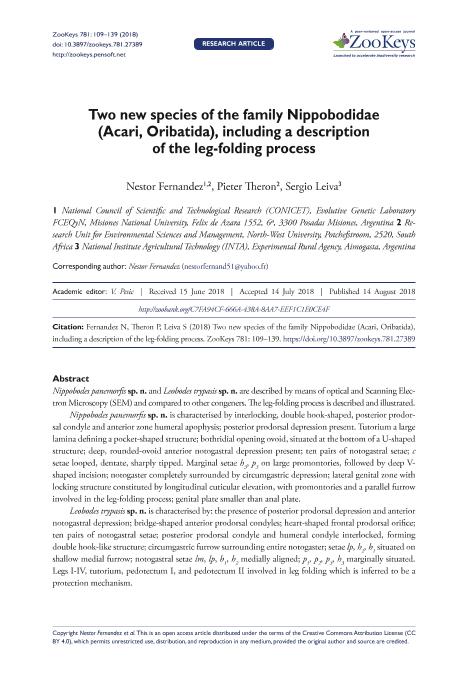Mostrar el registro sencillo del ítem
dc.contributor.author
Fernández, Néstor Alfredo

dc.contributor.author
Theron, Pieter

dc.contributor.author
Leiva, Sergio

dc.date.available
2020-06-23T20:38:10Z
dc.date.issued
2018-08-14
dc.identifier.citation
Fernández, Néstor Alfredo; Theron, Pieter; Leiva, Sergio; Two new species of the family Nippobodidae (Acari, Oribatida), including a description of the leg-folding process; Pensoft Publishers; ZooKeys; 781; 14-8-2018; 109-139
dc.identifier.issn
1313-2989
dc.identifier.uri
http://hdl.handle.net/11336/108029
dc.description.abstract
Nippobodes panemorfis sp. n. and Leobodes trypasis sp. n. are described by means of optical and Scanning ElectronMicroscopy (SEM) and compared to other congeners. The leg-folding process is described and illustrated.Nippobodes panemorfis sp. n. is characterised by interlocking, double hook-shaped, posterior prodorsalcondyle and anterior zone humeral apophysis; posterior prodorsal depression present. Tutorium a largelamina defining a pocket-shaped structure; bothridial opening ovoid, situated at the bottom of a U-shapedstructure; deep, rounded-ovoid anterior notogastral depression present; ten pairs of notogastral setae; csetae looped, dentate, sharply tipped. Marginal setae h3, p3 on large promontories, followed by deep Vshapedincision; notogaster completely surrounded by circumgastric depression; lateral genital zone withlocking structure constituted by longitudinal cuticular elevation, with promontories and a parallel furrowinvolved in the leg-folding process; genital plate smaller than anal plate.Leobodes trypasis sp. n. is characterised by: the presence of posterior prodorsal depression and anteriornotogastral depression; bridge-shaped anterior prodorsal condyles; heart-shaped frontal prodorsal orifice;ten pairs of notogastral setae; posterior prodorsal condyle and humeral condyle interlocked, formingdouble hook-like structure; circumgastric furrow surrounding entire notogaster; setae lp, h2, h1 situated onshallow medial furrow; notogastral setae lm, lp, h1, h2 medially aligned; p1, p2, p3, h3 marginally situated.Legs I-IV, tutorium, pedotectum I, and pedotectum II involved in leg folding which is inferred to be aprotection mechanism.
dc.format
application/pdf
dc.language.iso
eng
dc.publisher
Pensoft Publishers

dc.rights
info:eu-repo/semantics/openAccess
dc.rights.uri
https://creativecommons.org/licenses/by-nc-sa/2.5/ar/
dc.subject
systematics
dc.subject
Nippobodidae
dc.subject
new cuticular structures
dc.subject
Leg-folding process
dc.subject.classification
Otras Ciencias Biológicas

dc.subject.classification
Ciencias Biológicas

dc.subject.classification
CIENCIAS NATURALES Y EXACTAS

dc.title
Two new species of the family Nippobodidae (Acari, Oribatida), including a description of the leg-folding process
dc.type
info:eu-repo/semantics/article
dc.type
info:ar-repo/semantics/artículo
dc.type
info:eu-repo/semantics/publishedVersion
dc.date.updated
2020-06-08T15:19:34Z
dc.identifier.eissn
1313-2970
dc.journal.volume
781
dc.journal.pagination
109-139
dc.journal.pais
Bulgaria

dc.journal.ciudad
Sofia
dc.description.fil
Fil: Fernández, Néstor Alfredo. Consejo Nacional de Investigaciones Científicas y Técnicas. Centro Científico Tecnológico Conicet - Nordeste; Argentina. Universidad Nacional de Misiones. Facultad de Ciencias Exactas, Químicas y Naturales; Argentina
dc.description.fil
Fil: Theron, Pieter. North-West University; Sudáfrica
dc.description.fil
Fil: Leiva, Sergio. Instituto Nacional de Tecnología Agropecuaria. Agencia De Extensión Rural Aimogasta; Argentina
dc.journal.title
ZooKeys

dc.relation.alternativeid
info:eu-repo/semantics/altIdentifier/url/http://zoobank.org/References/C7FA94CF-666A-438A-8AA7-EEF1C1E0CE4F
dc.relation.alternativeid
info:eu-repo/semantics/altIdentifier/doi/http://dx.doi.org/10.3897/zookeys.781.27389
Archivos asociados
